Research on the Performance Characteristics of a Waste Heat Recovery Compound System for Series Hybrid Electric Vehicles
Abstract
:1. Introduction
2. Methodology and Assumption
2.1. System Description
2.2. The SHEV Model
2.3. Performance Indicators
2.4. Model Verification
3. Results and Analysis
3.1. Sensitivity Analysis of the Expander Speed and Pump Speed
3.2. Sensitivity Analysis of the WF Mass Flow Rate
3.3. Working Fluid Selection
4. Discussion
5. Conclusions
- The pump speed of an ORC system or compound cycle system has a great influence on the output power of the system. The pump is the key component responsible for transporting the working medium, and its speed directly affects the flow rate of the working fluid and the heat transfer efficiency of the system. In addition, the working state of the engine has a more direct impact on the output power of the system. The increase in the engine speed will lead to an increase in the exhaust gas flow, thus improving the system power output. The composite system achieves an improvement in the maximum power output under different engine conditions, and the power output and engine thermal efficiency ratio are better than the independent system, showing the advantages of the composite system in energy recovery.
- At a low engine speed, the influence of the working medium’s mass flow rate is limited. With a high-speed engine, the sensitivity of the working medium’s mass flow rate is enhanced. Under high-load conditions, increasing the working medium’s mass flow rate appropriately can improve the system performance. Under different engine conditions, selecting the appropriate working medium mass flow rate can maximize the system’s output power and efficiency.
- Comparing the five working mediums, R1234yf and R1234ze are the preferred candidates for the working medium of a waste heat recovery compound system in terms of the system’s output power, ETEIR, and environmental impact.
Author Contributions
Funding
Data Availability Statement
Conflicts of Interest
Nomenclatures
| Nomenclature | Acronyms | ||
| P | power (kW) | AC | air conditioning |
| Q | refrigerating capacity (kJ) | ACCM | AC cycle mode |
| W | consumed power (kW) | CCM | compound cycle mode |
| Subscripts | COP | coefficient of performance | |
| EDC | European driving cycle | ||
| EG | exhaust gas | ||
| aux | auxiliary | ETEIR | engine thermal efficiency increase ratio |
| b | battery | GWP | global warming potential |
| com | consumed | HEV | hybrid electric vehicle |
| eng | engine | ICE | internal combustion engine |
| exp | expander | ISG | integrated starter generator |
| exp, compound | expander in compound cycle | ODP | ozone depletion potential |
| exp, ORC | expander in ORC | ORC | organic Rankine cycle |
| gen | generator | ORCM | ORC mode |
| net | net output | OS | oil storage |
| net, compound | net output in compound cycle | SHEV | series hybrid electric vehicle |
| net, ORC | net output in ORC | SI | spark ignition |
| pump, compound | pump in compound cycle | SOC | state of charge |
| pump, ORC | pump in ORC | TEM | thermoelectric module |
| ref | refrigeration | WF | working fluid |
| tm | traction motor | WHR | waste heat recovery |
| WHRCS | waste heat recovery compound system | ||
Appendix A
| Comparative Parameters | R134a | R1234yf | R404A | R1233zd | R1234ze |
|---|---|---|---|---|---|
| Molar Mass (g/mol) | 102.03 | 114.04 | 97.60 | 130.51 | 114.0 |
| Critical Temperature (°C) | 101.1 | 94.7 | 71.97 | 165.6 | 109.4 |
| Critical Pressure (MPa) | 4.07 | 3.38 | 3.72 | 35.7 | 3.636 |
| Critical Density (kg/m3) | 511 | 475 | 484.17 | 478.92 | 1163.0 |
| Normal Boil Point (°C) | −26.2 | −29.5 | −46.8 | 18.32 | −18.95 |
| GWP (100 years) | 1300 | 4 | 0.94 | 1 | <1 |
| ODP | 0 | 0 | 0 | 0 | 0 |
| Safety Group | A1 | A2 | A1 | A1 | A2 |
| Remark | HFC | HFO | HFC | HFO | HFO |
References
- Wang, A.; Xu, J.; Zhang, M.; Zhai, Z.; Song, G.; Hatzopoulou, M. Emissions and fuel consumption of a hybrid electric vehicle in real-world metropolitan traffic conditions. Appl. Energy 2022, 306, 118077. [Google Scholar] [CrossRef]
- Sato, S.; Jiang, Y.J.; Russell, R.L.; Miller, J.W.; Karavalakis, G.; Durbin, T.D.; Johnson, K.C. Experimental driving performance evaluation of battery-powered medium and heavy duty all-electric vehicles. Int. J. Electr. Power 2022, 141, 108100. [Google Scholar] [CrossRef]
- Feng, H.; Ye, J.; Xiong, W.; Gong, Q.; Xu, J. Delay-Dependent MIMO Robust Control for Power Following System of Auxiliary Power Unit in Series Hybrid Electric Vehicles. IEEE Trans. Veh. Technol. 2021, 70, 4353–4365. [Google Scholar] [CrossRef]
- Zhuang, W.C.; Li, S.B.; Zhang, X.W.; Kum, D.; Song, Z.Y.; Yin, G.D.; Ju, F. A survey of powertrain configuration studies on hybrid electric vehicles. Appl. Energy 2020, 262, 114553. [Google Scholar] [CrossRef]
- Domingues, A.; Santos, H.; Costa, M. Analysis of vehicle exhaust waste heat recovery potential using a Rankine cycle. Energy 2013, 49, 71–85. [Google Scholar] [CrossRef]
- Aghaali, H.; Ngstrm, H.E. A review of turbocompounding as a waste heat recovery system for internal combustion engines. Renew. Sust. Energ. Rev. 2015, 49, 813–824. [Google Scholar] [CrossRef]
- Rodriguez, R.; Preindl, M.; Cotton, J.S.; Emadi, A. Review and Trends of Thermoelectric Generator Heat Recovery in Automotive Applications. IEEE Trans. Veh. Technol. 2019, 68, 5366–5378. [Google Scholar] [CrossRef]
- Lin, S.; Zhao, L.; Deng, S.; Ni, J.X.; Zhang, Y.; Ma, M.L. Dynamic performance investigation for two types of ORC system driven by waste heat of automotive internal combustion engine. Energy 2019, 169, 958–971. [Google Scholar] [CrossRef]
- Takahisa, Y.; Tomohiko, F.; Norio, A.; Koichi, M. Design and testing of the Organic Rankine Cycle. Energy 2014, 3, 239–251. [Google Scholar]
- Shafikhani, I.; Aslund, J. Analytical Solution to Equivalent Consumption Minimization Strategy for Series Hybrid Electric Vehicles. IEEE Trans. Veh. Technol. 2021, 70, 2124–2137. [Google Scholar] [CrossRef]
- Anselma, P.G.; Biswas, A.; Belingardi, G.; Emadi, A. Rapid assessment of the fuel economy capability of parallel and series—Parallel hybrid electric vehicles. Appl. Energy 2020, 275, 115319. [Google Scholar] [CrossRef]
- Hsiao, Y.Y.; Chang, W.C.; Chen, S.L. A mathematic model of thermoelectric module with applications on waste heat recovery from automobile engine. Energy 2010, 35, 1447–1454. [Google Scholar] [CrossRef]
- Smith, K.; Thornton, M. Feasibility of Thermoelectric for Waste Heat Recovery in Hybrid Vehicles; National Energy Research Lab. (NREL): Golden, CO, USA, 2007; p. CP-540-42256. [Google Scholar]
- Wang, R.C.; Wei, Y.; Meng, X.P. Performance investigation and energy optimization of a thermoelectric generator for a mild hybrid vehicle. Energy 2018, 162, 1016–1028. [Google Scholar] [CrossRef]
- Vijayagopal, R.; Rousseau, A. Impact of TEGs on the Fuel Economy of Conventional and Hybrid Vehicles; SAE Technical Papers; SAE International: Warrendale, PA, USA, 2015; Volume 28, pp. 2835–2838. [Google Scholar]
- Fang, W.; Quan, S.H.; Xie, C.J.; Tang, X.F.; Ran, B.; Jiao, Y.T. Energy optimization for a weak hybrid power system of an automobile exhaust thermoelectric generator. J. Electron. Mater. 2017, 46, 6617–6627. [Google Scholar] [CrossRef]
- Deng, Y.D.; Fan, W.; Ling, K. A 42–V electrical and hybrid driving system based on a vehicular waste–heat thermoelectric generator. J. Electron. Mater. 2012, 41, 1698–1705. [Google Scholar] [CrossRef]
- Galloni, E.; Fontana, G.; Staccone, S. Design and experimental analysis of a mini ORC (organic Rankine cycle) power plant based on R245fa working fluid. Energy 2015, 90, 768–775. [Google Scholar] [CrossRef]
- Shu, G.Q.; Zhao, M.R.; Tian, H.; Wei, H.Q.; Liang, X.Y.; Huo, Y.Z.; Zhu, W.J. Experimental investigation on thermal OS/ORC (Oil Storage/Organic Rankine Cycle) system for waste heat recovery from diesel engine. Energy 2016, 107, 693–706. [Google Scholar] [CrossRef]
- Zhang, Y.M.; Han, Y.Q.; Yan, J.Y.; Chen, R.L. Thermodynamic analysis of compound cycle system for automotive waste heat recovery and air conditioning refrigeration. Energ. Convers. Manag. 2018, 168, 32–48. [Google Scholar] [CrossRef]
- Braimakis, K.; Karellas, S. Integrated thermoeconomic optimization of standard and regenerative ORC for different heat source types and capacities. Energy 2017, 121, 570–598. [Google Scholar] [CrossRef]
- Trapp, C.; Colonna, P. Efficiency Improvement in Precombustion CO2 Removal Units with a Waste–Heat Recovery ORC Power Plant. J. Eng. Gas. Turb Power 2013, 135, 042311. [Google Scholar] [CrossRef]
- Mastrullo, R.; Mauro, A.W.; Revellin, R.; Viscito, L. Modeling and optimization of a shell and louvered fin mini–tubes heat exchanger in an ORC powered by an internal combustion engine. Energy Convers. Manag. 2015, 101, 697–712. [Google Scholar] [CrossRef]
- Shu, G.Q.; Yu, G.P.; Tian, H.; Wei, H.Q.; Liang, X.Y.; Huang, Z.Y. Multi-approach evaluations of a cascade-Organic Rankine Cycle (C-ORC) system driven by diesel engine waste heat, Part A—Thermodynamic evaluations. Energy Convers. Manag. 2016, 108, 579–595. [Google Scholar] [CrossRef]
- Uusitalo, A.; Honkatukia, J.; Backman, J.; Nyyssönen, S. Experimental study on charge air heat utilization of large–scale reciprocating engines by means of Organic Rankine Cycle. Appl. Therm. Eng. 2015, 89, 209–219. [Google Scholar] [CrossRef]
- Song, J.; Song, Y.; Gu, C.W. Thermodynamic analysis and performance optimization of an Organic Rankine Cycle (ORC) waste heat recovery system for marine diesel engines. Energy 2015, 82, 976–985. [Google Scholar] [CrossRef]
- Zhang, H.G.; Wang, E.H.; Fan, B.Y. A performance analysis of a novel system of a dual loop bottoming organic Rankine cycle (ORC) with a light–duty diesel engine. Appl. Energy 2013, 102, 1504–1513. [Google Scholar] [CrossRef]
- Song, J.; Gu, C.W. Analysis of ORC (Organic Rankine Cycle) systems with pure hydrocarbons and mixtures of hydrocarbon and retardant for engine waste heat recovery. Appl. Therm. Eng. 2015, 89, 693–702. [Google Scholar] [CrossRef]
- Yang, K.; Zhang, H.G.; Song, S.S.; Zhang, J.; Wu, Y.T.; Zhang, Y.Q.; Wang, H.J.; Chang, Y.; Bei, C. Performance analysis of the vehicle diesel engine-ORC combined system based on a screw expander. Energies 2014, 7, 3400–3419. [Google Scholar] [CrossRef]
- Shu, G.Q.; Gao, Y.Y.; Tian, H.; Wei, H.Q.; Liang, X.Y. Study of mixtures based on hydrocarbons used in ORC (Organic Rankine Cycle) for engine waste heat recovery. Energy 2014, 74, 428–438. [Google Scholar] [CrossRef]
- Hogerwaard, J.; Dincer, I.; Zamfirescu, C. Analysis and assessment of a new organic Rankine-based heat engine system with/without cogeneration. Energy 2013, 62, 300–310. [Google Scholar] [CrossRef]
- Di Cairano, L.; Nader, W.B.; Nemer, M. A simulation and experimental study of an innovative MAC/ORC/ERC system, ReverCycle with an ejector for series hybrid vehicles. Energy 2021, 230, 120830. [Google Scholar] [CrossRef]
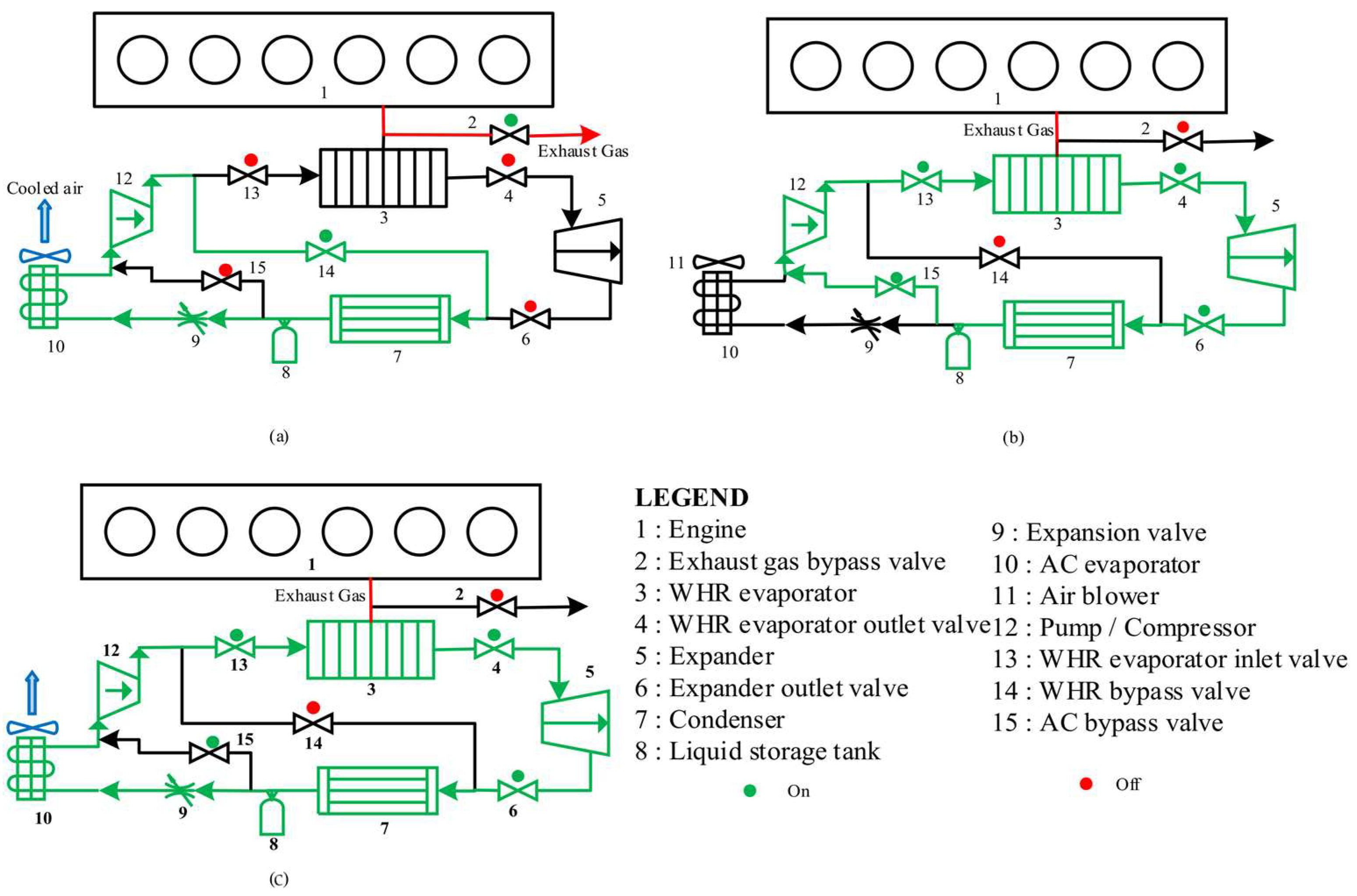
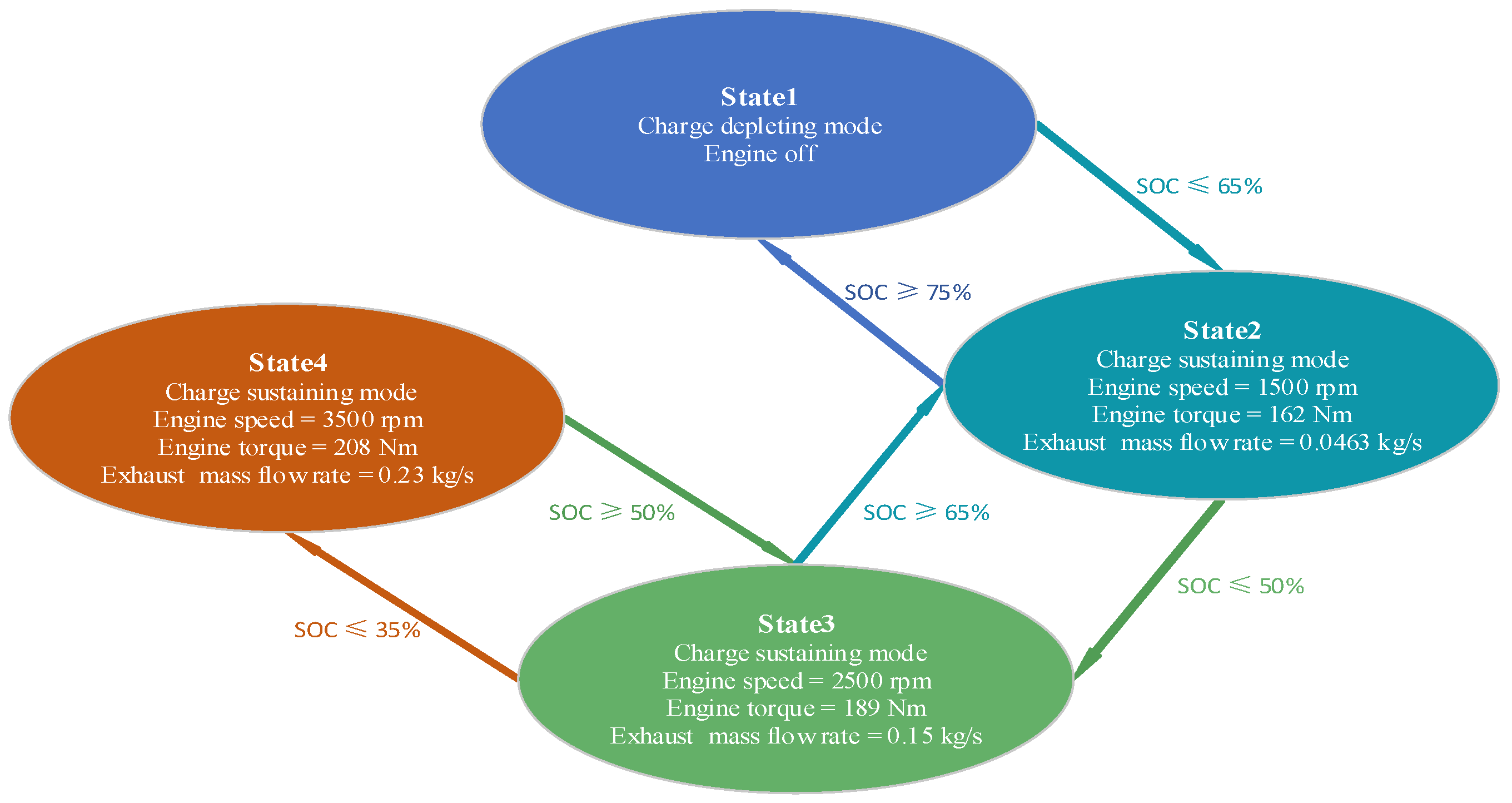
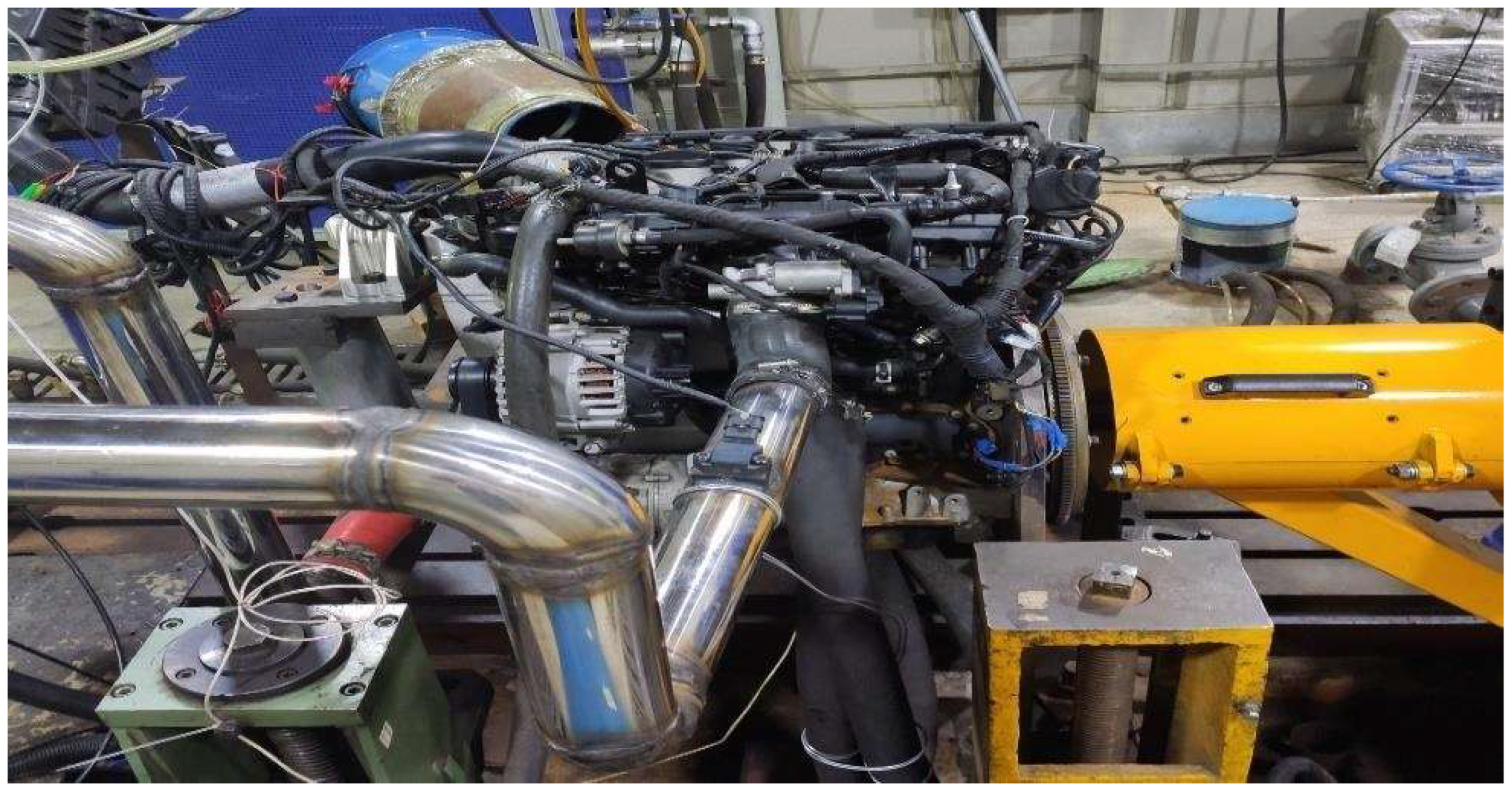
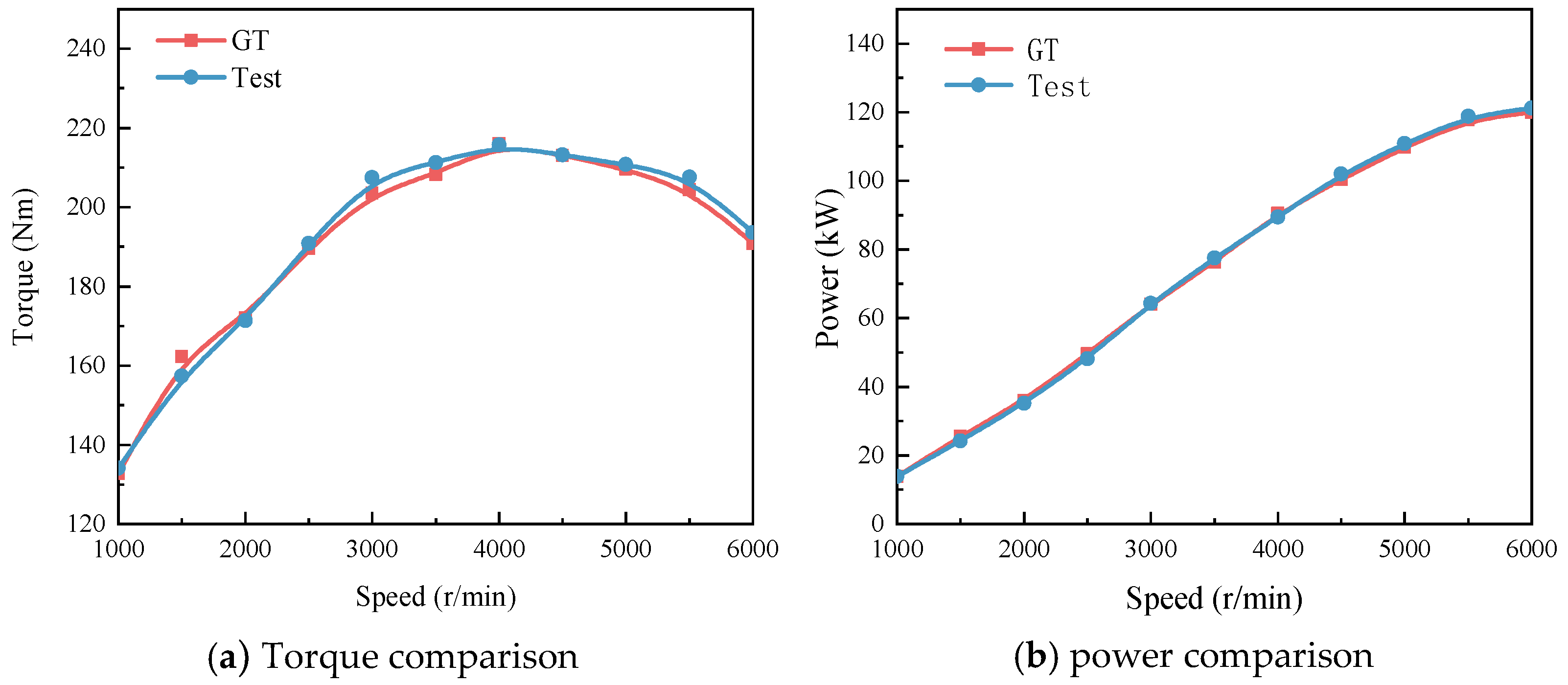
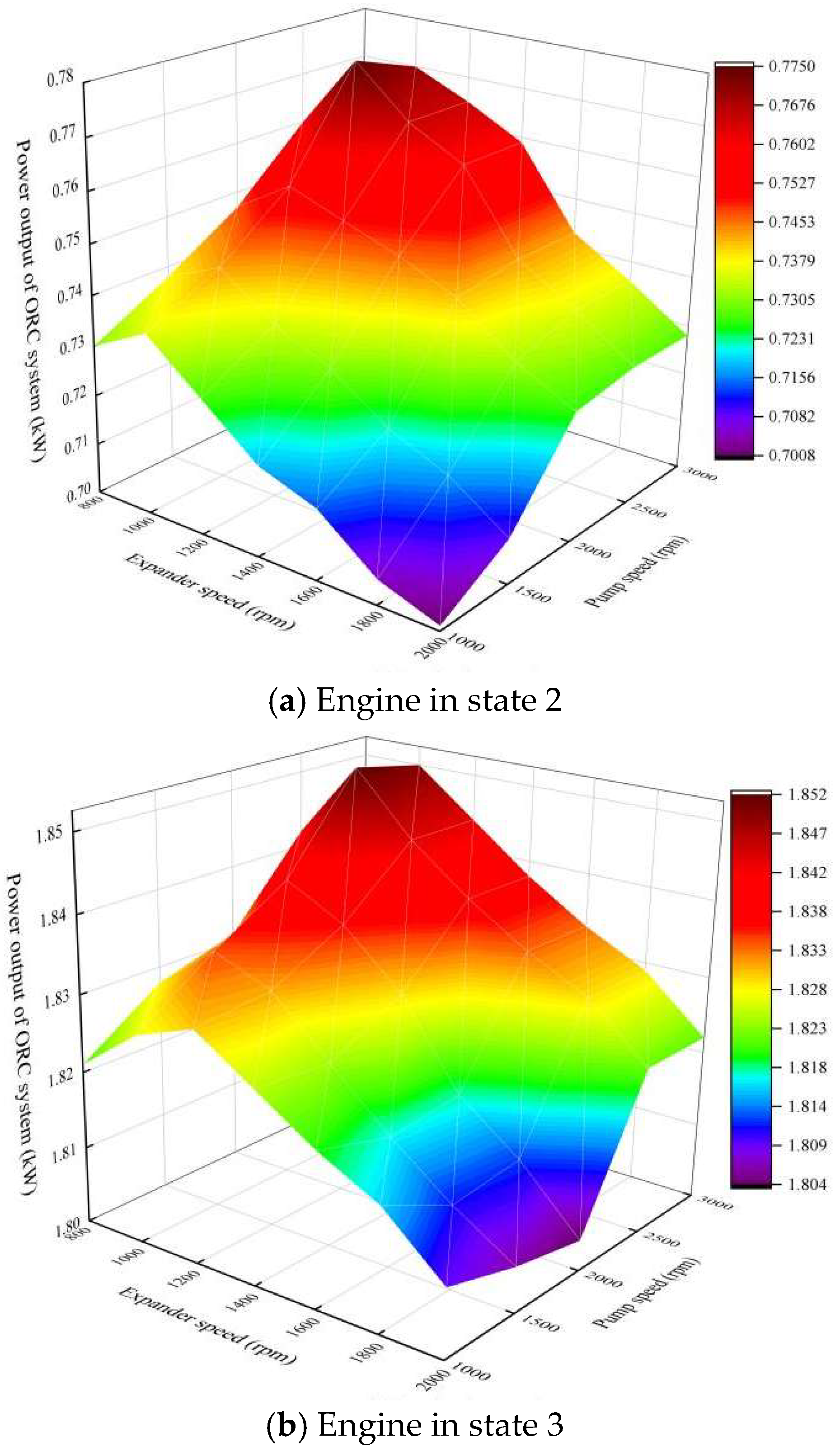
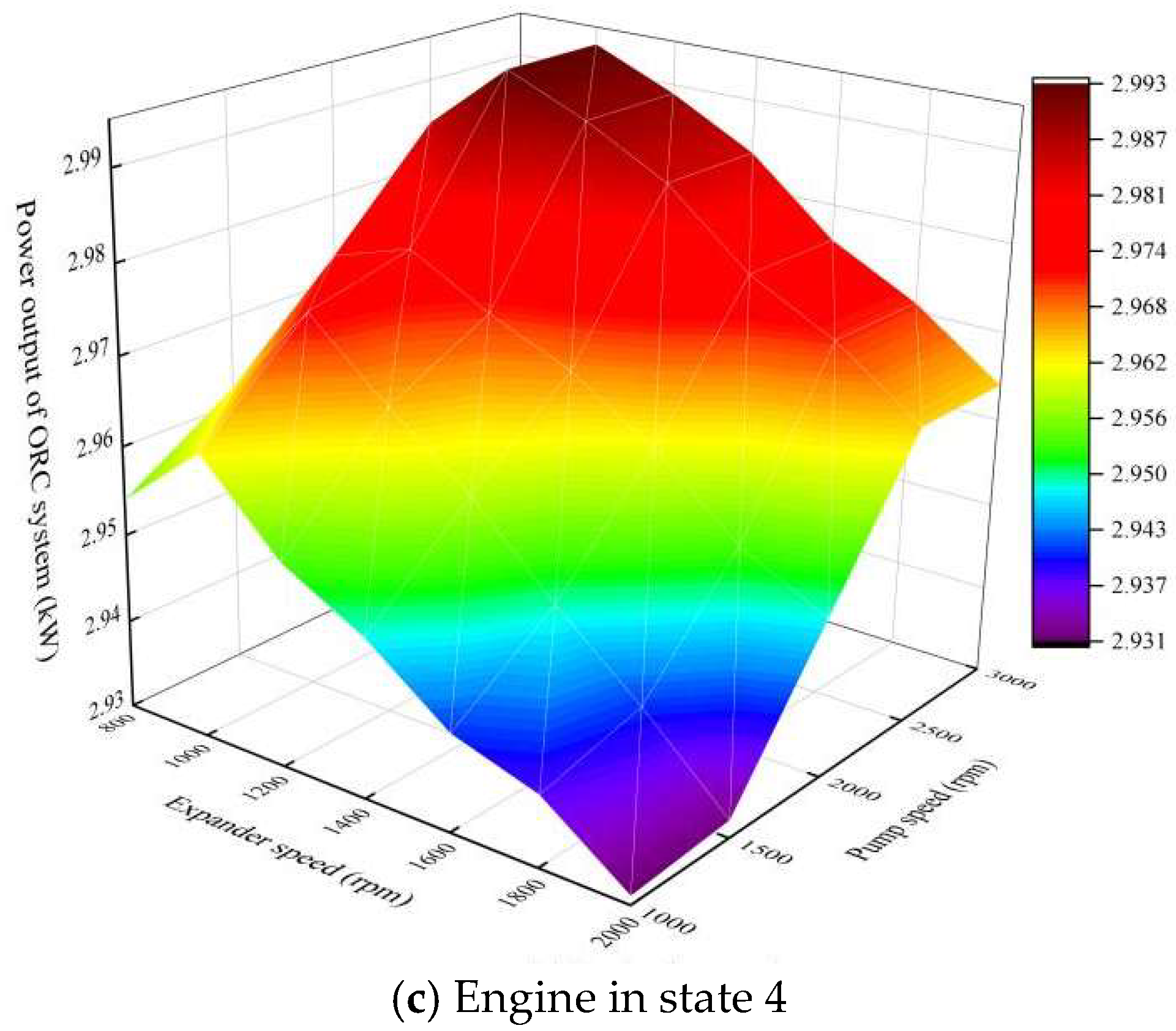

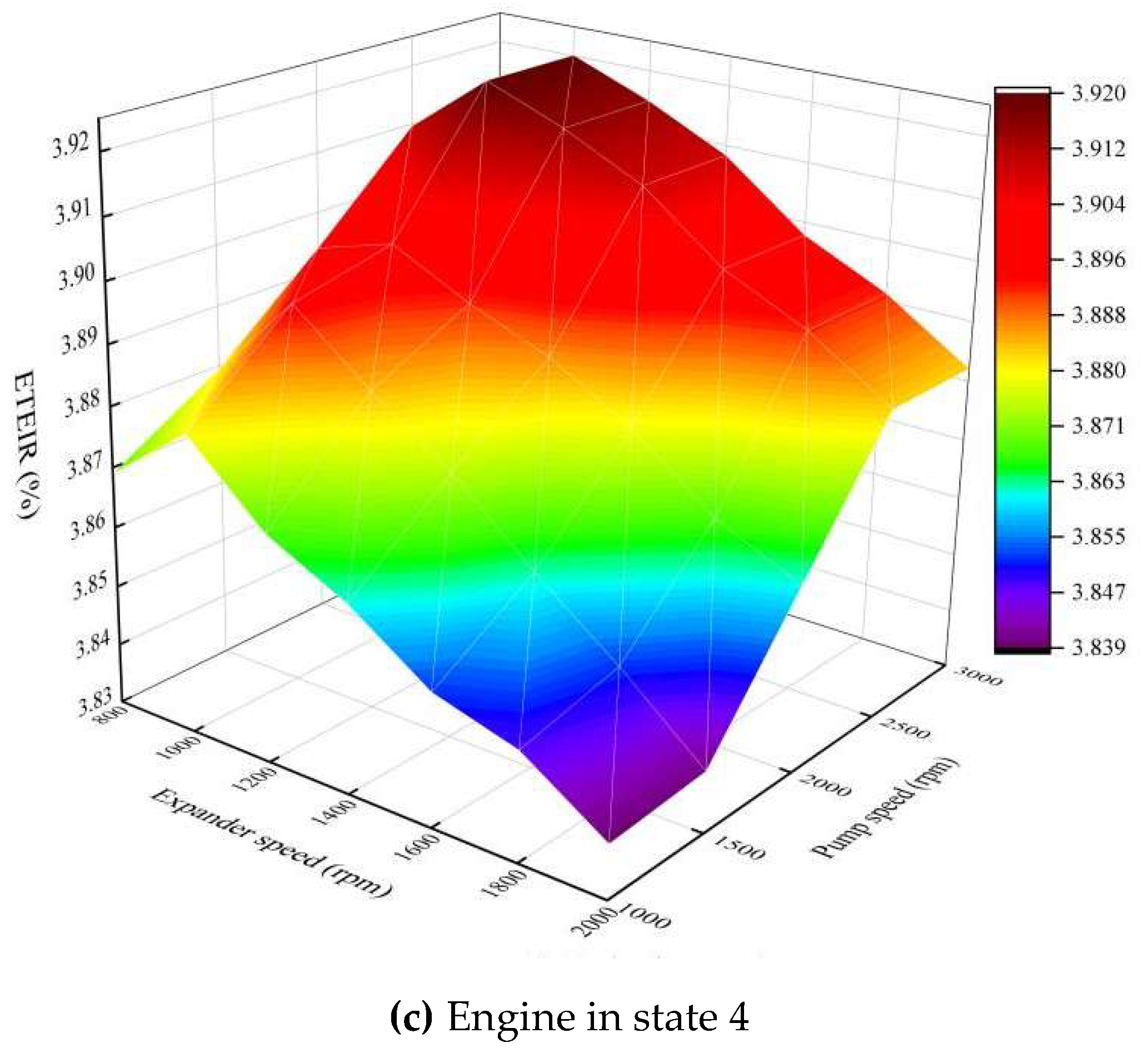

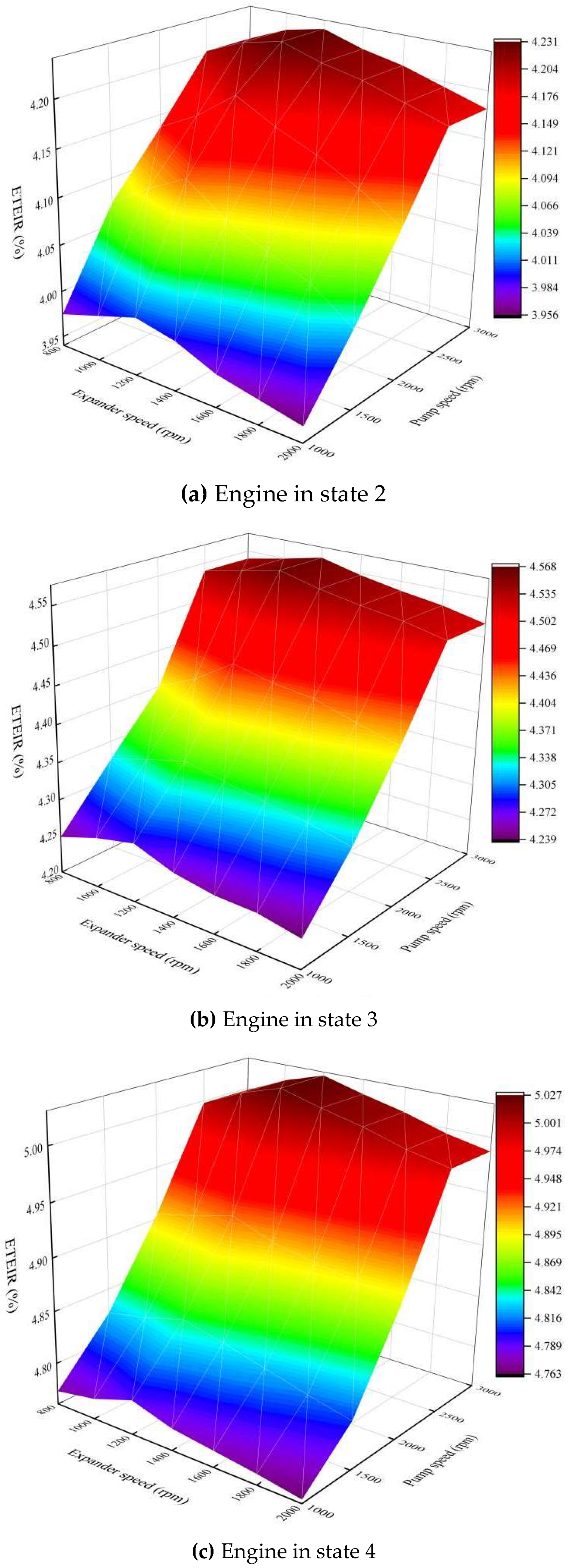



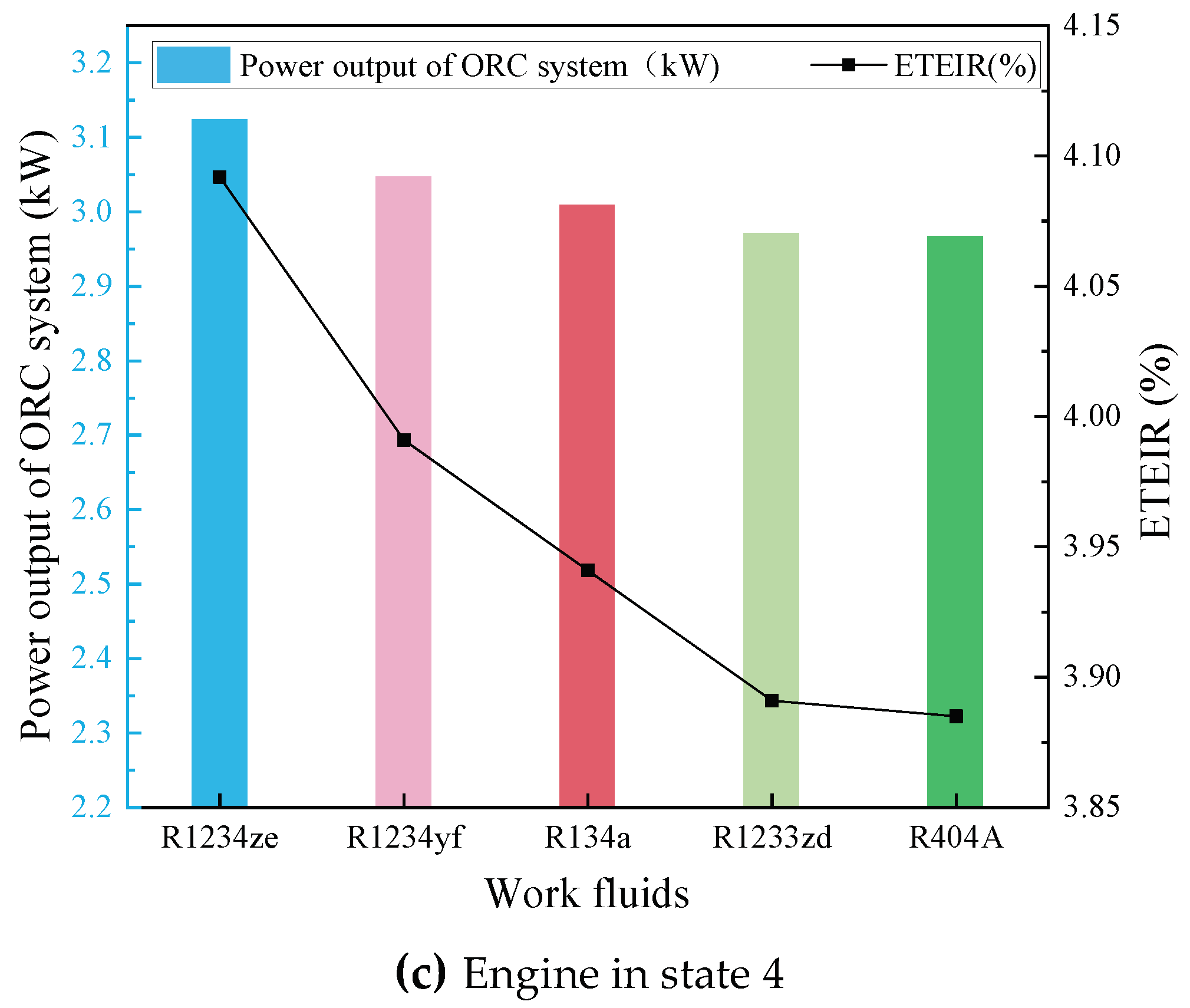
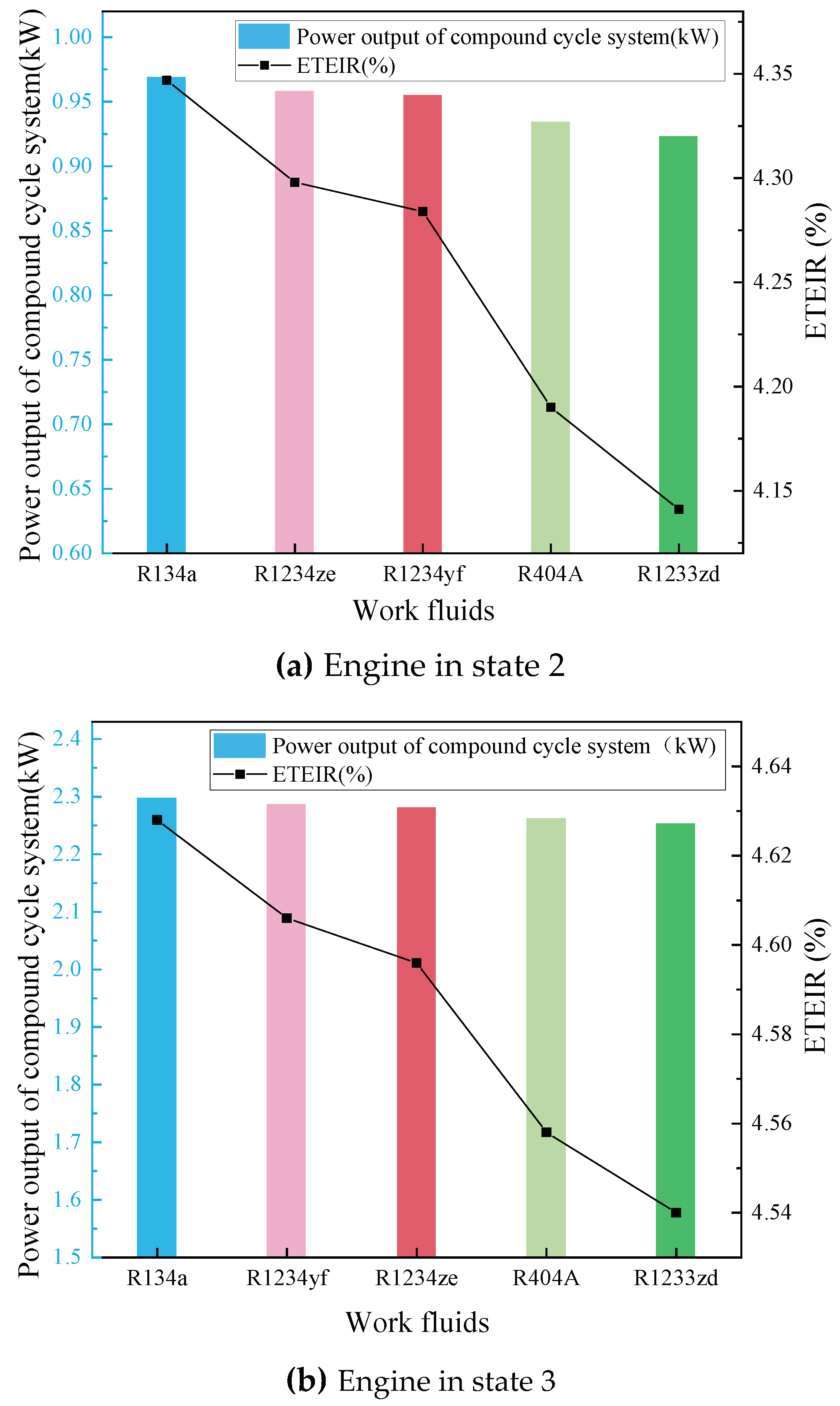

| Project | Parameters | Project | Parameters |
|---|---|---|---|
| Vehicle type | SHEV | Fuel injection method | Direct injection |
| ICE peak power (kW) | 120 | Combustion method | Homogeneous combustion |
| Total engine displacement (L) | 2.0 | Supercharging method | Exhaust turbocharged |
| Number of cylinders | 4 | Fuel system | High-pressure common rail |
| Battery capability (kWh) | 20 | Vehicle weight (kg) | 1600 |
| Compression ratio | 17.0 | Maximum power of generator (kW) | 60 |
| Battery pack voltage (V) | 260 | Maximum generator efficiency | 95% |
| Engine Speed (rpm) | Torque (Nm) | Output Power (kW) | EG Mass Flow Rate (kg/s) | EG Temperature (°C) |
|---|---|---|---|---|
| 1000 | 132.76 | 13.92 | 0.0263 | 621 |
| 1500 | 162.33 | 22.29 | 0.0463 | 627 |
| 2000 | 172.04 | 33.03 | 0.0742 | 629 |
| 2500 | 189.58 | 49.63 | 0.15 | 630 |
| 3000 | 203.58 | 63.95 | 0.16 | 631 |
| 3500 | 208.32 | 76.35 | 0.23 | 634 |
| 4000 | 216.08 | 90.51 | 0.28 | 636 |
| 4500 | 213.07 | 100.40 | 0.42 | 638 |
| 5000 | 209.60 | 109.74 | 0.45 | 642 |
| 5500 | 204.38 | 117.71 | 0.55 | 643 |
| System | WF | Parameters | Results of the Existing Research | Results in This Paper |
|---|---|---|---|---|
| AC system | R134a | COP | 2.07 [26] | 2.24 |
| ORC system | R134a | Output power (kW) | 0.16~0.4 [20] | 0.796~3.009 |
| ETEIR (%) | 2.67~3.9 [20] | 3.57~3.94 | ||
| Compound system | R134a | Output power (kW) | 9.2~9.87 [20] | 0.958~3.856 |
| ETEIR (%) | 5.04~5.37 [20] | 4.29~5.05 |
Disclaimer/Publisher’s Note: The statements, opinions and data contained in all publications are solely those of the individual author(s) and contributor(s) and not of MDPI and/or the editor(s). MDPI and/or the editor(s) disclaim responsibility for any injury to people or property resulting from any ideas, methods, instructions or products referred to in the content. |
© 2024 by the authors. Licensee MDPI, Basel, Switzerland. This article is an open access article distributed under the terms and conditions of the Creative Commons Attribution (CC BY) license (https://creativecommons.org/licenses/by/4.0/).
Share and Cite
Dang, H.; Han, Y. Research on the Performance Characteristics of a Waste Heat Recovery Compound System for Series Hybrid Electric Vehicles. Processes 2024, 12, 605. https://doi.org/10.3390/pr12030605
Dang H, Han Y. Research on the Performance Characteristics of a Waste Heat Recovery Compound System for Series Hybrid Electric Vehicles. Processes. 2024; 12(3):605. https://doi.org/10.3390/pr12030605
Chicago/Turabian StyleDang, Huifang, and Yongqiang Han. 2024. "Research on the Performance Characteristics of a Waste Heat Recovery Compound System for Series Hybrid Electric Vehicles" Processes 12, no. 3: 605. https://doi.org/10.3390/pr12030605





